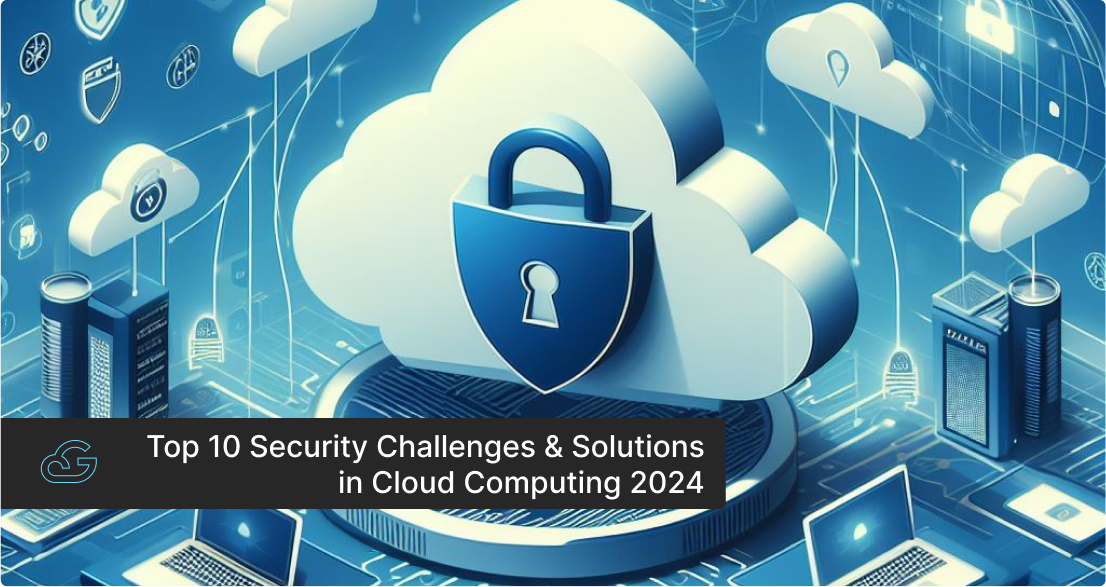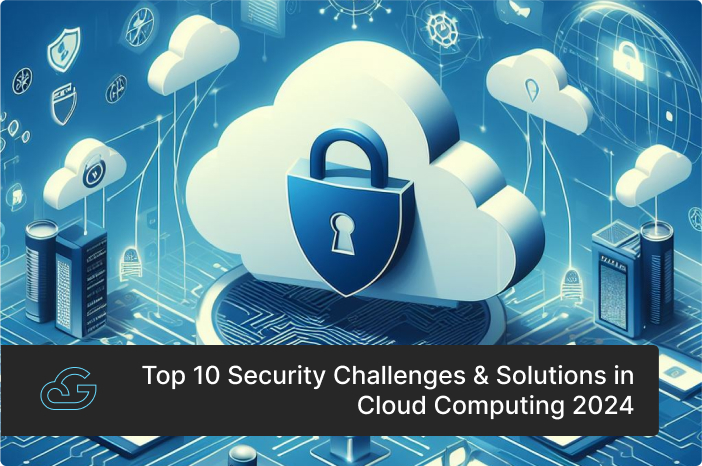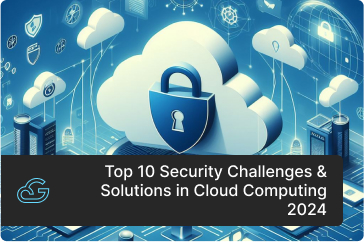Blogs / Cloud Security
Top 10 Security Challenges & Solutions in Cloud Computing 2024
By
Harish K K
Posted: April 8, 2024
• 7 minutes and 42 seconds
Nearly every organization has adopted cloud technology to some extent, pulled in by its salient benefits. Yet, this transformation comes with a crucial responsibility - safeguarding the ever-growing volume of customer data and systems entrusted to the cloud. From unintended data exposure to vulnerabilities stemming from human error, the security risks inherent in cloud computing are expected to rise alongside its adoption.
To withstand emerging security threats, businesses are increasingly seeking solutions to keep their data safe in the cloud. The global cloud security software market is expected to reach $37 billion by 2026. As we move on to 2024, organizations must confront the looming threats to cloud security head-on. This blog highlights the main security issues plaguing cloud environments this year, along with the effective solutions to keep the data safe.
Key Areas We’ll Cover:
- Top cloud security threats facing organizations in the cloud.
- Impact of human error and poor security hygiene on cloud security.
- Emerging security challenges posed by artificial intelligence in the cloud.
- Solutions to eliminate security risks and strengthen your cloud environment.
Top 10 Cloud Security Challenges & their Solutions of 2024
-
The Rise of AI-Powered Threats
The advancement of AI technology may introduce negative impacts on cloud security. Hackers are utilizing AI to create self-learning malware, that can understand and adapt past security systems to defend against it and exploit new vulnerabilities. They have even exploited popular AI tools like ChatGPT to cheat developers into accidentally downloading malicious software. Furthermore, AI-powered DDoS (Distributed Denial of Services) attacks will be more sophisticated, targeting weaknesses identified through real-time analysis.
Solution: Fight back with a Pre-built AI Counterpart
- Regularly educate your team on the latest AI threats to allow them to recognize and report suspicious activity.
- Utilize AI-powered security tools to streamline threat detection, automated response, and predictive analytics.
- Integrate security platforms that combine cloud environment data, vulnerability databases, and AI analysis to identify and prioritize potential weaknesses in your software and configuration.
-
Phishing Scams and Social Engineering Attacks
Phishing scams and social engineering attacks are types of cyber threats that manipulate human psychology to trick individuals into revealing sensitive information or carrying out specific actions. Phishing involves sending fraudulent emails, messages, or websites that appear legitimate to trick recipients into revealing personal information such as login credentials, financial details, or other sensitive data. Social engineering attacks manipulate human behavior to gain unauthorized access to systems or information. This can include tactics such as impersonation, pretexting, or exploiting trust.
Both these threats are constantly evolving. They leverage AI-powered deepfakes and personalized communication to manipulate trust and trick individuals into compromising sensitive information or granting unauthorized access.
Solution – Strengthen Access Management and Authorization
- Invest in training programs to educate IT staff on phishing red flags and social engineering tactics.
- Enforce MFA (Multi-Factor Authentication) for all users, especially those with high-level access. This adds an extra layer of security beyond passwords.
- Implement robust Identity and Access Management (IAM) controls in the cloud to restrict unauthorized access to critical assets.
-
Complexity in Managing Multi-Cloud Data Security Settings
Multi-cloud environments offer flexibility, but managing their security involves complex processes. Each cloud provider has a unique set of security configurations, policies, and even terminology. This creates multi-headed complications for administrators, making it difficult to maintain consistent security and prevent misconfigurations.
Solution: Introduce Centralized Cloud Management Visibility for Enhanced Security
- Implement a Cloud Security Posture Management (CSPM) or Cloud Native Application Protection Platform (CNAPP) solution. These tools provide a centralized view of security configurations and assets across all your cloud platforms.
- Utilize automated tools to streamline configuration tasks and reduce the risk of human error.
- Develop standardized security policies and procedures for all your cloud environments to simplify management and minimize complexity.
-
Growing Concerns Over Data Leakage and Data Theft in Cloud Environment
Data Leakage and Data Theft are a constant threat in the cloud. Data Leakage occurs when data is inadvertently shared or transmitted to unauthorized individuals or systems. In data theft incidents, attackers intentionally access, copy, or steal sensitive data such as personal information, financial data, and intellectual property without permission.
Attackers target unsecured data, weak credentials, and misconfigured environments leaving sensitive information vulnerable to theft. Stolen data like social security numbers and internal documents can be used for identity theft, reputation damage, and financial loss.
Solution: Implement Proper Encryption, Authentication, and Security Assessment
- Encrypt your data at rest and in transit before it leaves your systems and while stored in the cloud. Also, ensure strict control over encryption keys to prevent unauthorized access to data.
- Implement Multi-Factor Authentication (MFA) to request additional verification beyond a simple username and password.
- Regularly assess the effectiveness of authentication protocols to maintain robust security measures.
-
Non-Compliance Risks in Cloud Environments
Non-compliance with regulations like PCI-DSS can expose companies to severe consequences, including penalties and fines. Maintaining compliance often requires creating isolated network segments and restricting access to authorized personnel. However, the challenge intensifies when cloud service providers fail to comply with industry security standards, potentially leading to compliance violations.
Solution: Establish, Implement, and Maintain Regulatory Compliance Standards
- Initiate and enforce privacy and compliance policies to protect organizational resources.
- Develop a governance framework that clearly define the compliance requirements within your organization.
- Clearly outline each employee's roles and responsibilities in policies, including communication protocols to ensure adherence to compliance standards.
-
Risks Associated with Unsecured APIs
APIs allow cloud services to connect with your existing business applications, databases, and tools. While APIs allow for customization of cloud services, they also pose significant security risks. APIs are often well-documented for ease of use. This same openness can create security risks if left unsecured. Hackers exploit these vulnerabilities through brute-force attacks, denial-of-service (DoS) attempts, or man-in-the-middle (MITM) tactics.
Solutions: Enhance API Security Through Regular API Audits & API Activity Monitoring
- Simulate real-world attacks through penetration testing to identify and improve vulnerabilities before attackers exploit them.
- Conduct regular security audits to assess the health of your API security posture and identify areas for improvement.
- Enforce robust authentication protocols to prevent unauthorized access to your APIs.
- Continuously monitor API activity for suspicious behaviour that might indicate an attack.
-
Misconfigurations in Cloud Services
Misconfigurations in cloud services can result from various factors, including human error, inadequate security protocols, the complexity of cloud environments, and the multitude of services offered by different vendors. Rushed deployments, incomplete documentation, and failure to follow best practices in configuration management can also lead to misconfigurations. These vulnerabilities are prime targets for attackers, potentially exposing sensitive data, disrupting critical infrastructure, and leading to costly breaches.
Solutions: Ensure Secure Configuration Through Standardization and Automated Process
- Implement consistent security policies and leverage automation tools to scan and audit your cloud configurations regularly.
- Maintain ongoing monitoring of your cloud environment to detect and address any misconfigurations before they become security breaches.
- Provide comprehensive training on cloud security best practices for your security teams.
-
Account Hijacking
The main cause of account hijacking is weak password hygiene practices, like password reuse and simple passwords. A single stolen credential can be a master key, granting attackers access to sensitive data, disrupting core operations, or compromising entire customer accounts. This risk is amplified as businesses migrate more essential functions to cloud-based infrastructure. Additionally, inadequate authentication measures and phishing attacks further exacerbate the risk of account hijacking.
Solutions: Enforce strong password protection practices and training programs
- Implement strict password policies that require complex, unique passwords for all accounts.
- Enable MFA as an added layer of security, requiring a secondary verification step beyond just a username and password.
- Ensure your cloud storage provider has a robust business continuity plan in place, including regular testing of security measures.
-
DoS and DDoS Attacks
Both Denial-of-Service (DoS) and Distributed Denial-of-Service (DDoS) attacks aim to break your online presence.
In a DoS attack, a single source floods a target system, such as a website or server, with excessive traffic, requests, or data. This makes the system unusable and inaccessible and disrupts its regular operations. DoS attacks can be launched by a single attacker using techniques like sending numerous requests or exploiting vulnerabilities to exhaust system resources.
In a DDoS attack, multiple sources, often compromised computers or devices forming a botnet, collectively flood a target system with traffic. DDoS attacks are typically more potent and difficult to mitigate than DoS attacks due to the distributed nature of the attack, making it harder to identify and block malicious traffic sources.
Solutions: Employ strong defense mechanisms to protect your systems and network
- Deploy an IDS (Intrusion Detection System) to monitor your network for suspicious activity and identify potential DoS/DDoS attacks early on.
- Configure your firewall to analyze incoming traffic and filter out malicious requests. This helps prevent unwanted traffic from reaching your systems.
- Consider partnering with a cloud security service provider who can absorb and deflect large-scale attacks before they overwhelm your infrastructure.
- Implement rate limiting to restrict the number of requests a single user or IP address can send within a specific timeframe. This helps prevent a single source from overwhelming your system.
- Maintain regular backups of your data to ensure you can restore critical information if a DoS attack disrupts your systems.
-
The Quantum Threat to Passwords
Quantum computing is a revolutionary technology that combines the principles of quantum mechanics to perform calculations at an exponential rate. This power poses a significant threat to traditional encryption methods like RSA (Rivest–Shamir–Adleman). Old encryption methods once thought to be impossible to crack, can be broken by quantum computers much faster than traditional computers.
The possible arrival of this critical moment is called "Q-day." On the Q-day, quantum computers will have the capability to break current encryption, cracking the security of sensitive data stored everywhere - from financial records to confidential communications. This means the passwords we rely on today could become obsolete, leaving our data exposed.
Solutions: Design preventive measures to sustain the upcoming quantum threats
- Pursue the development of quantum-resistant cryptographic algorithms or post-quantum cryptography.
- Follow quantum computing advancements and proactively adapt encryption strategies to withstand the attack of future quantum computers.
- Don't wait for Q-day. Begin migrating to post-quantum cryptography to ensure a smooth transition and continued data security.
Get Advanced Cloud Protection with Gsoft Cloud Services
The challenges we've outlined are not insoluble. The intensity of these challenges varies based on factors like organization size, industry, and existing IT infrastructure Their impact can be mitigated with the right approach, tailored to your unique needs and existing infrastructure. Gsoft Cloud understands that a successful cloud journey requires a comprehensive strategy built on three pillars:
- The latest security solutions and cloud-optimized toolsets.
- Your organization's readiness to fight back against security threats.
- A proactive approach that makes your cloud environment remain secure and optimized.
Connect with our cloud security experts today to get comprehensive solutions and strategic insights to overcome challenges and optimize your cloud infrastructure. www.gsoftcomm.net/contact-us.


Get Know More About Our Services and Products
Reach to us if you have any queries on any of our products or Services.











